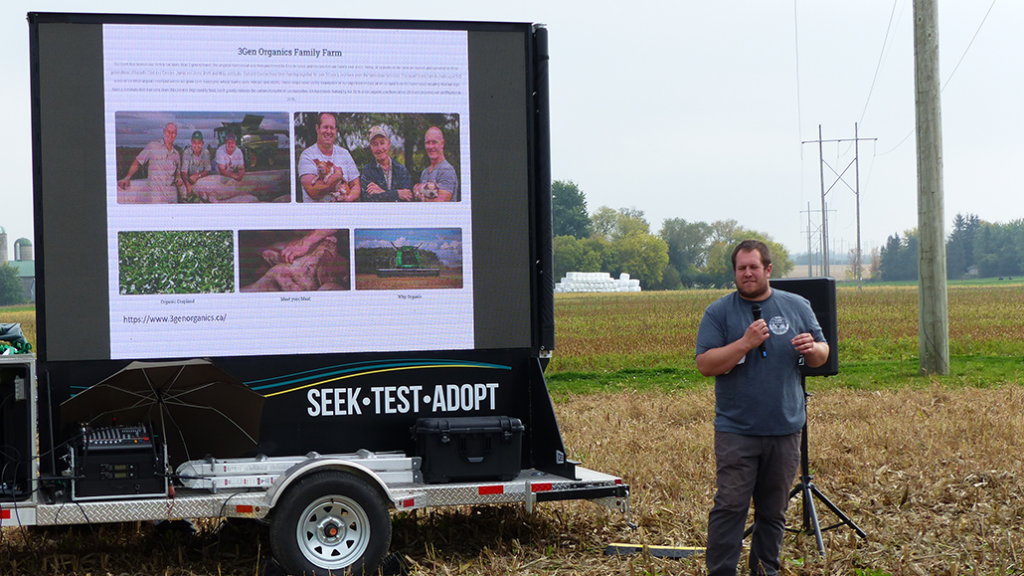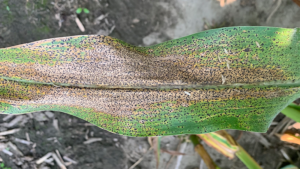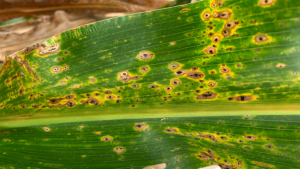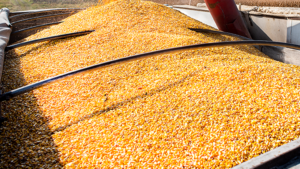Digging deeper into soil health
MSTS GIVES GROWERS A NEW PERSPECTIVE

BEFORE THE ADVENT of drone technology, issues in the field could only be seen from the ground and tractor level. Using drone technology provided a whole new perspective, allowing growers to see problems in the field as they developed and, for the first time, visualize how they could be better managed. New technology, the Mobile Soil Technology Suite (MSTS), offers growers new perspectives — some of them quite literally groundbreaking. Funded by the Ontario Ministry of Agriculture, Food and Rural Affairs (OMAFRA) and overseen by the Ontario Soil and Crop Improvement Association (OSCIA), MSTS is available for soil-related events this summer.
MSTS is a mobile demonstration suite that consists of two trailers. The first trailer is a lab of sorts that houses equipment that supports applied soil research, and it is equipped with water, power and air, as well as specialized scientific tools. The second trailer carries a 7-foot by 10-foot high-resolution LED screen and sound equipment that can be used to demonstrate data from sensors, presentations, and video — either pre-recorded or footage captured live on-site — at field events.
IDEA IS SPARKED
The idea for the mobile suite first blossomed at a soil compaction event where similar technology was used to measure soil pressure from different-sized farm equipment. To do this, weigh scales were buried beneath the soil’s surface, and using sensors, event organizers tested 75 configurations of equipment in an attempt to understand the balance and weight on each tire and axle. Data from the sensors was projected directly onto a large LED screen, allowing growers to see firsthand how the soil reacted under heavy equipment.
OMAFRA crop innovation specialist Ian MacDonald recalls that having audiovisual equipment greatly improved the overall experience and, therefore, growers’ understanding of how equipment causes soil compaction. He also recalls the hefty price tag that came with the rental equipment. Realizing that having regular access to this type of equipment could seriously improve soil health and crop demonstration, he and a couple of colleagues at OMAFRA put together a funding proposal. The idea was to take field extension and the understanding of soil management to the next level.
“What happens under our feet is sort of blind to us,” says MacDonald. “It’s at such a microscopic level that we struggle to comprehend it. We reasoned that, as people, we really learn by seeing things.”
UNLIMITED POTENTIAL
Beyond assessing real-time soil compaction risks, MSTS has countless applications — many of them unrealized. For instance, it can highlight water-holding capacity by showing how water filters through the soil. Live video footage from a GoPro camera fixed to a drone could be projected onto the high-resolution screen to show variability in a field. Being able to do this allows demonstrators to draw attention to the impact of different management strategies on soil health, water quality and even crop condition. The best applications, says MacDonald, are those that show activity.
“Having the big video screen is really no different than making videos and showing them indoors in the wintertime at different events,” he says. “But being able to dig the soil and show them wormholes, for instance. Focus in on that, put it up on the big screen where you actually see the worms moving in real-time. I think it’s more powerful.”
Brittany Roka, OSCIA association development advisor, says the possibilities are endless in terms of what MSTS can offer.
“We’re just like scratching the surface of all the activities that we can do,” she says. “We’re just getting it out there across the province and kind of showcasing what it can do.”
While the initial purchase cost was funded by OMAFRA, OSCIA covers overhead costs for storage, haulage and technicians. Currently, MSTS is stored at the Canada Outdoor Farm Show site near Woodstock, Ont. It’s weather-resistant, so it can be used even if rain tries to spoil the day.
Roka noted that although their focus as an organization is on soil and crops, MSTS is not commodity specific. Priority will be given to local and regional events where OSCIA is involved, including on-farm research sites and knowledge transfer events. Reservations can be made through OSCIA.
As knowledge transfer is the aim, Roka says it’s important to keep rental costs low.
“The MSTS speaks to who OSCIA is as an organization,” she says. “We’re all about the networking, the knowledge transfer, and working with other organizations.”
“We’re all about working together, and with this suite of tools, it gives us the opportunity to reach such a broad audience across the province of Ontario,” Roka concludes. •




















